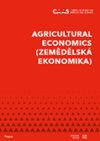合并奶牛场的DEA方法
IF 1.8
4区 经济学
Q2 AGRICULTURAL ECONOMICS & POLICY
引用次数: 6
摘要
本文提出了一个确定一组奶牛场中最有利合并的模型。利用数据包络分析(DEA)估计并购将产生的总技术效率提升,并将其分解为学习效应和纯并购效应。我们还设计了实验来检验各种因素(农场总数、牧群规模的标准差、农场规模收益增加的比例、农场当前技术效率的标准差)对不同响应变量(参与合并的农场比例、牧群规模的减少和合并所获得的效率的提高)的影响。结果表明,区域内养殖场规模的差异和规模收益递增的养殖场比例增加了进入最有利合并的养殖场数量。牛群规模的差异也增加了合并后不需要的奶牛数量。最后,预期的效率提高随着农场总数的增加而增加。本文章由计算机程序翻译,如有差异,请以英文原文为准。
A DEA approach for merging dairy farms
This paper proposes a model for determining the most advantageous merger within a set of dairy farms. It uses data envelopment analysis (DEA) to estimate the total technical efficiency improvement that the merger would produce and for decomposing it into a learning effect and a pure merger effect. A design of experiments has also been carried to test the effects of various factors (the total number of farms, the standard deviation of herd size, the percentage of farms exhibiting increasing returns to scale, the standard deviation of the current technical efficiency of the farms) on different response variables (the percentage of farms involved in the merger, the reduction of herd size and the efficiency improvement obtained by the merger). The results show that the disparity in the herd size of the farms in a region and the percentage of farms that exhibit increasing returns to scale increase the number of farms that enter into the most advantageous merger. The disparity of herd size also increases the number of cows that are not needed after the merger. Finally, the expected efficiency improvement increases with the total number of farms.
求助全文
通过发布文献求助,成功后即可免费获取论文全文。
去求助
来源期刊

Agricultural Economics-Zemedelska Ekonomika
Agricultural Economics & Policy-
CiteScore
4.30
自引率
4.50%
发文量
47
审稿时长
30 weeks
期刊介绍:
An international peer-reviewed journal published under the auspices of the Czech Academy of Agricultural Sciences and financed by the Ministry of Agriculture of the Czech Republic. Published since 1954 (by 1999 under the title Zemědělská ekonomika).Thematic scope:
original scientific papers dealing with agricultural subjects from the sphere of economics, management, informatics, ecology, social economy and sociology. Since 1993 the papers continually treat problems which were published in the journal Sociologie venkova a zemědělství until now. An extensive scope of subjects in fact covers the whole of agribusiness, that means economic relations of suppliers and producers of inputs for agriculture and food industry, problems from the aspects of social economy and rural sociology and finally the economics of the population nutrition. Papers are published in English.
 求助内容:
求助内容: 应助结果提醒方式:
应助结果提醒方式:


